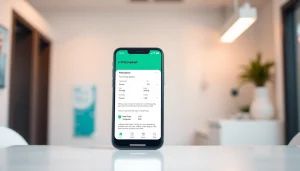Streamlining Patient Care: Benefits of Eprescribing Software for Doctors

Introduction to Eprescribing Software for Doctors
In the modern landscape of healthcare, technology plays an essential role in enhancing patient safety and improving the overall efficiency of medical practices. One such technology that has gained traction is eprescribing software for doctors. This innovative tool is designed to streamline the prescription process, allowing healthcare providers to send prescriptions electronically to pharmacies, thus minimizing the potential for errors that can occur with traditional handwritten methods.
What is Eprescribing Software?
Eprescribing software is a digital application that enables healthcare providers to write and transmit prescriptions electronically. It typically integrates with electronic health records (EHR) systems to facilitate seamless access to a patient’s medical history, current medications, and allergies. By leveraging technology, eprescribing software helps physicians write prescriptions with speed and accuracy while ensuring adherence to pharmacy regulations.
Importance of Eprescribing in Modern Healthcare
The significance of eprescribing in today’s healthcare environment cannot be overstated. It addresses various challenges faced by both prescribers and patients, such as medication errors, delays in receiving prescriptions, and the inefficiencies of manual processes. With the rise of patient-centered care, where providers seek to engage patients actively in their treatment plans, eprescribing software has become a pivotal component of healthcare delivery.
Key Features of Effective Eprescribing Software
Effective eprescribing software comes equipped with a variety of essential features, including:
- Medication History Access: Allows prescribers to view a patient’s medication history and prevent potential drug interactions.
- Drug Interaction Alerts: Automatically notifies physicians about possible adverse interactions between prescribed medications.
- PMP Integration: Interfaces with Prescription Monitoring Programs (PMPs) to check for controlled substance prescriptions.
- Mobile Compatibility: Provides access via mobile devices, allowing physicians to prescribe medications from various locations.
- User-Friendly Interface: Ensures that the application is intuitive, facilitating quick training and adoption by healthcare staff.
Advantages of Eprescribing Software for Doctors
Enhanced Prescription Accuracy and Safety
One of the primary benefits of using eprescribing software is the significant improvement in prescription accuracy. By eliminating the potential for misinterpretation of handwritten prescriptions, doctors can reduce medication errors. Studies have shown that electronic prescriptions have lower rates of adverse drug events compared to traditional prescribing methods.
Improved Patient Convenience and Compliance
Eprescribing software enhances patient convenience by allowing them to receive their medications more quickly. Patients can choose where they would like their prescriptions fulfilled, thus reducing the wait time at pharmacies. Additionally, the use of reminders and automated refill notices can improve adherence to medication regimens, positively impacting patient health outcomes.
Time-Saving Benefits for Healthcare Providers
Time efficiency is critical in healthcare, and eprescribing software aids in optimizing workflow for healthcare providers. By streamlining the prescribing process, physicians can spend less time producing and managing prescriptions, allowing them to focus more on patient care and reducing patient wait times.
Challenges and Considerations in Implementing Eprescribing Software
Common Barriers in Adoption
Despite its advantages, the adoption of eprescribing software can face several challenges. Some of these include resistance to change among staff, concerns regarding data security, and the financial implications of implementation. By addressing these barriers through change management strategies and demonstrating the long-term benefits of the software, practices can ease the transition process.
Integration with Existing Systems
Integration with existing electronic health record systems is crucial for the successful implementation of eprescribing software. Organizations need to ensure that the software they choose can seamlessly connect with their current systems. This interoperability facilitates data sharing and ensures that healthcare providers have access to comprehensive patient information.
Training and Support for Healthcare Staff
A significant consideration when implementing eprescribing software is providing adequate training and ongoing support for users. Investing in training sessions and resources can alleviate concerns associated with using new technology and promote a positive user experience. Staff should feel confident and comfortable with the software to fully utilize its features.
Best Practices for Using Eprescribing Software for Doctors
Obtaining Necessary Certifications and Compliance
Healthcare providers must prioritize compliance with legal and regulatory requirements when using eprescribing software. This includes ensuring that the software is certified for use in their respective states and adheres to guidelines set forth by governmental bodies. Staying informed about regulatory changes will safeguard practices from penalties and enhance patient trust.
Ensuring Data Security and Patient Privacy
With the transition to digital solutions, data security and patient privacy have become paramount. Effective eprescribing software should utilize encryption, strong authentication protocols, and user access controls to protect sensitive patient information. Additionally, regular audits and updates of security measures should be implemented to address emerging threats.
Regularly Updating Software and Training
It is crucial for healthcare organizations to ensure that their eprescribing software is kept up to date with the latest features and security enhancements. Providers should also encourage continual education for their staff on new functionalities and best practices to maximize the efficiency and efficacy of the software.
Future Trends in Eprescribing Software for Doctors
The Role of AI and Machine Learning
The incorporation of artificial intelligence (AI) and machine learning technologies holds great promise for the future of eprescribing software. These technologies can analyze vast amounts of data to support clinical decision-making, streamline workflows further, and personalize medication management for patients. As these technologies advance, healthcare providers can expect increased efficiency and improved patient outcomes.
Integration with Telehealth Services
The rise of telehealth services has necessitated the integration of eprescribing software with virtual consultation platforms. This synergy allows healthcare providers to prescribe medications during telehealth visits seamlessly. As remote care continues to grow, having a robust eprescribing system that integrates with telehealth tools will be critical in maintaining continuity of care.
Patient Engagement and Mobile Applications
In an era where patient engagement is becoming increasingly vital, integrating eprescribing software with mobile applications can further empower patients. Through mobile apps, patients can manage their prescriptions, receive reminders, and communicate with their providers. Enhancing direct communication can lead to greater adherence and satisfaction among patients.







